How Long Does Regenerative Medicine Take to Work?
You're considering regenerative medicine. You understand how it works. You know it targets the root cause instead of just covering up symptoms.
But you want to know: when will I actually feel better?
It's the most common question people ask, and it deserves an honest answer.
Regenerative medicine isn't instant. It's not like taking a pain pill that kicks in within an hour or getting a cortisone shot that works by tomorrow.
Regenerative medicine helps your body rebuild damaged tissue from the inside out. That's a biological process, and biology doesn't happen overnight.
The payoff? Results that last. You're not getting temporary relief that fades after a few weeks. You're getting actual tissue repair that changes your pain and function long-term.
So what's the real timeline? It depends on the treatment type, how severe your condition is, and several factors unique to your body and situation.
Understanding the Healing Process

Before talking timelines, you need to understand what's happening inside your body after a regenerative medicine treatment.
When PRP or stem cells get injected into damaged tissue, your body doesn't immediately start building new cartilage or repairing torn ligaments. There's a sequence of events that has to unfold.
Right after the injection, your body triggers inflammation. This isn't a bad thing despite how it feels. The inflammation clears out damaged tissue and prepares the area for repair. During this first week, you might actually feel worse. Soreness, swelling, and increased discomfort are normal responses. It's a sign the treatment is working, not failing.
Weeks two through six are when the real work begins. The growth factors and healing signals start directing your body to rebuild tissue. New collagen fibers form. Blood flow increases to the area. Cells multiply and organize into functional tissue.
You won't see dramatic changes yet, but subtle improvements start showing up. Pain decreases slightly. Function improves a bit. Activities that were difficult become manageable.
Weeks six through twelve and beyond is when tissue matures and strengthens. The new collagen fibers align properly. The tissue becomes more resilient. Pain continues to decrease as structural integrity improves.
By the end of this phase, most people see significant improvement. Some conditions take longer—up to three to six months for full results—but the direction is clear.
Why Regenerative Medicine Can't Be Rushed
Your body has its own timeline for healing. There's no shortcut.
When you take pain medication, it blocks pain signals in your nervous system. That happens within minutes or hours because nothing is actually healing. You're just changing how your brain perceives the pain.
Regenerative medicine is fundamentally different because it's rebuilding tissue. That requires cellular division, collagen formation, blood vessel development, and tissue maturation. All of that happens on a biological clock you can't speed up.
Think of building a house. You can't skip the foundation and jump to the roof. Each phase has to complete before the next one begins.
Your body works the same way. It has to clear out damaged tissue before building new tissue. It has to lay down new collagen before it can strengthen and remodel that collagen.
Trying to rush the process by overusing the injured area too soon can set you back. Patience isn't optional in regenerative medicine.
PRP Therapy Timeline: What to Expect
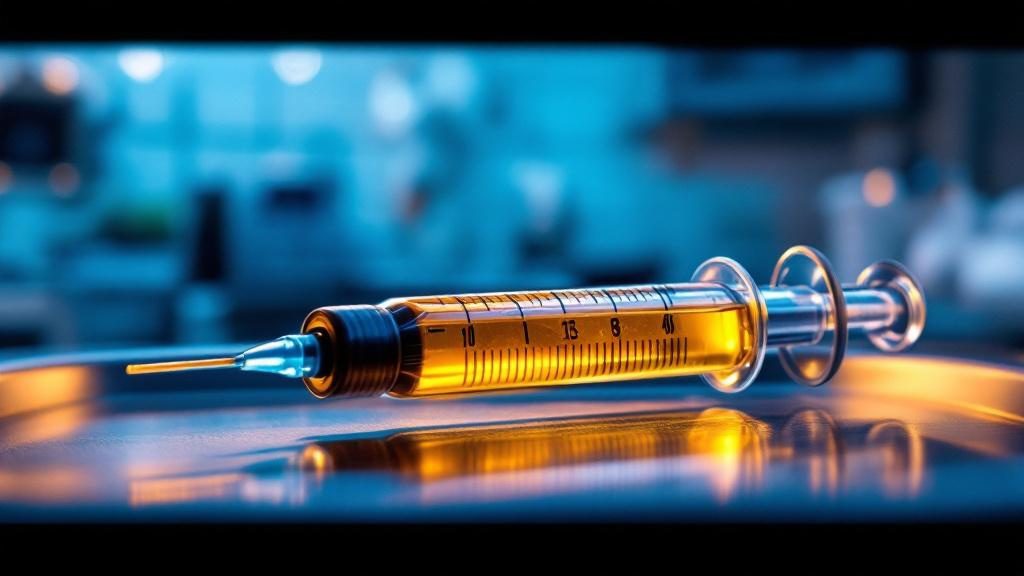
PRP therapy is one of the faster regenerative treatments, but faster is relative.
Most people start noticing improvement around the four to six week mark. Some see changes as early as two to three weeks. Others don't see significant results until eight to ten weeks.
The timeline depends on several factors: how severe the injury is, how long you've been dealing with it, and how well your body responds to treatment.
Tendon injuries like tennis elbow or Achilles tendonitis typically show results within four to eight weeks. Tendons are slow healers because they don't get much blood flow, but PRP accelerates the process significantly.
Ligament sprains that haven't fully healed usually improve in the six to ten week range. The ligament tissue needs time to rebuild strength and stability.
Early-stage arthritis often shows pain reduction around four to six weeks as inflammation decreases and cartilage health improves. Full results can take three to four months.
Muscle injuries can work faster—sometimes within three to four weeks—because muscle tissue has better blood flow and heals more efficiently than tendons or ligaments.
Many people need more than one PRP treatment. It's common to do a series of two to three injections spaced four to six weeks apart to achieve optimal results.
Why Some People Respond Faster Than Others
Not everyone heals at the same speed. That's completely normal.
Age plays a role. Younger people tend to respond faster because their cells divide more quickly and their healing mechanisms are more efficient. That doesn't mean older adults can't benefit—it just might take longer.
Overall health matters. Conditions like diabetes, autoimmune disorders, or poor circulation slow your healing timeline. When your body is already under stress, tissue repair is affected.
The severity of damage is a huge factor. A mild tendon strain heals faster than a severe tear. Early-stage arthritis responds quicker than advanced degeneration.
Activity level after treatment affects results. Following post-treatment guidelines and giving your body time to heal produces faster results. Jumping back into intense activity too soon slows the process or undoes progress.
Working with a provider who sets realistic expectations based on your specific situation matters. Cookie-cutter timelines don't work in regenerative medicine because every person and every injury is different.
Stem Cell Therapy Timeline: What to Expect
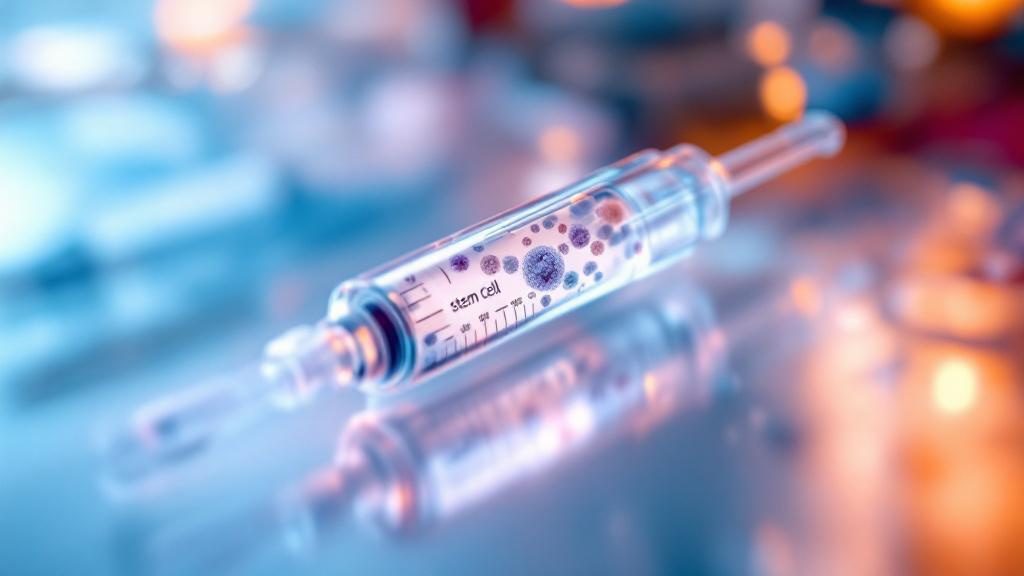
Stem cell therapy takes longer to show results than PRP, but the results tend to be more dramatic.
Most people start noticing improvement around the eight to twelve week mark. Some see changes earlier. Others don't see full results until four to six months after treatment.
Why does it take longer? Stem cells aren't just accelerating healing—they're regenerating tissue your body couldn't repair on its own.
That's a more complex process than what PRP does. Stem cells have to differentiate into the right type of tissue, integrate with existing structures, and mature into functional cells. All of that takes time.
Moderate to severe arthritis can take three to six months to show full results with stem cell therapy. Early improvements in pain and mobility often show up around eight to ten weeks, but tissue regeneration continues for months.
Cartilage damage follows a similar timeline—three to six months for maximum benefit. Cartilage is notoriously slow to heal, and even with stem cells boosting the process, it doesn't happen overnight.
Severe ligament or tendon injuries typically show improvement in the ten to sixteen week range. The more damaged the tissue, the longer it takes to rebuild.
Degenerative disc disease sometimes shows pain relief within six to eight weeks, but the full regenerative effects can take four to six months as disc tissue slowly rebuilds.
Many people benefit from multiple treatments. Stem cell therapy isn't always a one-time solution. Complex or severe conditions often require follow-up treatments to achieve the best results.
The Difference Between Early Improvement and Full Results
Feeling better and being fully healed are two different things.
A lot of people start experiencing pain relief within the first six to eight weeks of stem cell therapy. That's because inflammation is decreasing and the healing process is underway.
But just because the pain is better doesn't mean the tissue is fully regenerated.
The tissue is still rebuilding. Still maturing. Still strengthening. Push too hard too soon and you risk re-injuring the area before repair is complete.
This is why follow-up care matters. Your provider needs to assess progress, make sure tissue is healing properly, and adjust activity levels as needed.
Full results take time, but they're worth the wait. Once tissue is fully regenerated and matured, the improvement is lasting—not temporary like a cortisone shot or pain medication.
Factors That Affect Your Healing Timeline
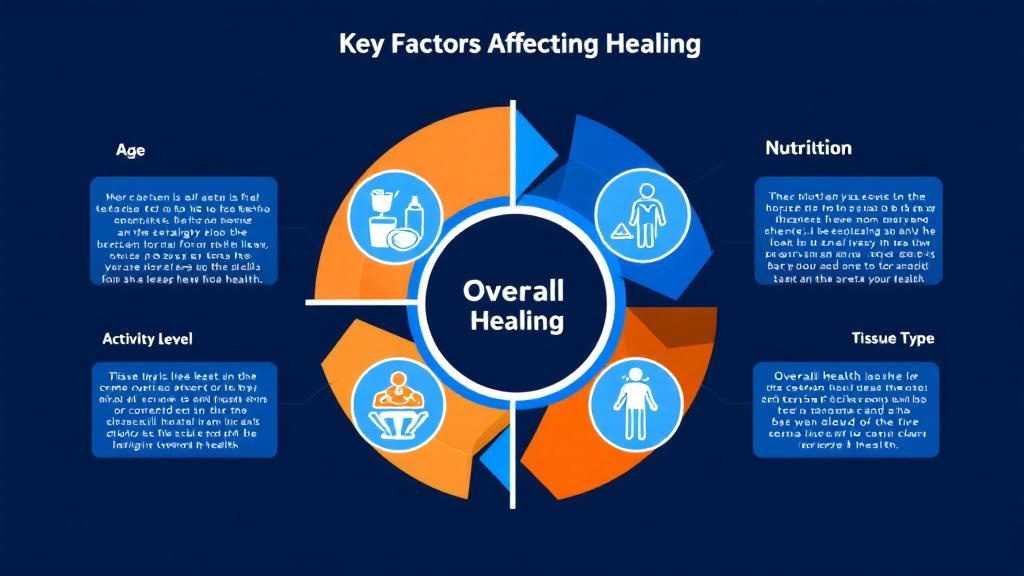
No two people heal at exactly the same speed. Your timeline depends on a combination of factors, some you can control and some you can't.
The nature of your injury or condition makes a difference. Acute injuries generally heal faster than chronic conditions. If you hurt yourself recently and get regenerative medicine treatment within weeks or months, your body responds more quickly. Chronic conditions present for years take longer. Your body has adapted to the damage, scar tissue has formed, and the healing process is more complex.
Different tissues heal at different rates. Muscle heals faster than tendon. Tendon heals faster than ligament. Cartilage heals slowest of all. This is just biology. Tissues with better blood flow heal more efficiently because they get more nutrients and oxygen. Tissues with poor blood flow—like cartilage and tendons—take longer even with regenerative medicine accelerating the process.
Some people are naturally faster healers. Genetics, overall health, immune function, nutrition, sleep quality—all of these influence how quickly your body rebuilds tissue. Good health, proper nutrition, adequate sleep, and effective stress management mean faster healing. Chronic health issues, poor nutrition, or high stress extend the timeline.
Compliance with post-treatment guidelines is huge. Following your provider's instructions—resting when you're supposed to rest, gradually increasing activity when cleared, attending follow-up appointments—means faster and better healing. Ignoring guidelines and jumping back into intense activity too soon slows healing or undoes progress.
Whether you're combining treatments matters too. Regenerative medicine works even better when combined with other therapies that support healing. Chiropractic care optimizes nervous system function, which controls tissue repair. Physical therapy strengthens surrounding muscles and improves movement patterns. Proper nutrition gives your body the raw materials it needs to rebuild tissue. People who take a comprehensive approach typically see faster and better results than those who rely on regenerative medicine alone.
How Your Lifestyle Impacts Healing Speed
Your daily habits matter more than you might think.
Nutrition is foundational. Your body needs protein, vitamins, minerals, and healthy fats to rebuild tissue. Poor nutrition deprives your body of resources it needs to heal.
Sleep is when tissue repair happens. Most rebuilding occurs during deep sleep. Without seven to nine hours of quality sleep, healing slows down.
Chronic stress elevates cortisol, which suppresses immune function and slows tissue repair. Managing stress isn't just good for mental health—it's critical for physical healing.
Activity level needs balance. Too much activity too soon damages healing tissue. Too little activity causes weakness and stiffness. Finding the right balance—guided by your provider—is essential.
Smoking is a dealbreaker. Nicotine constricts blood vessels, reduces oxygen delivery to tissues, and dramatically slows healing. There's no way around this. Smoking sabotages regenerative medicine results.
What Happens If Results Are Slower Than Expected?

Sometimes healing takes longer than anticipated. That doesn't mean the treatment failed—it means your body needs more time or additional support.
If you're not seeing expected improvement within the typical timeline, there are several possible reasons.
The damage might be more severe than initially thought. Imaging doesn't always show the full extent of tissue damage. Sometimes it's worse than it appears, which means it takes longer to repair.
Your body might need multiple treatments. One round of PRP or stem cells might not be enough for severe or chronic conditions. Many people need two to three treatments spaced weeks or months apart.
Other factors might be interfering with healing. Underlying health conditions, medications, poor nutrition, or lifestyle factors can all slow the process.
You might need complementary therapies. Sometimes regenerative medicine works better when combined with chiropractic care, physical therapy, or other supportive treatments.
Staying in communication with your provider is critical. If results are slower than expected, they can assess what's happening and adjust the treatment plan accordingly.
When to Consider a Follow-Up Treatment
Most regenerative medicine providers recommend re-evaluating progress around the eight to twelve week mark after initial treatment.
If you're seeing improvement but not complete resolution, a follow-up treatment can build on progress already made. Think of it as layering—each treatment adds more healing support until you reach your goal.
If you're seeing zero improvement by twelve weeks, that's a red flag. Either the diagnosis was wrong, the treatment wasn't appropriate for your condition, or something else is interfering with healing.
At that point, additional imaging, exploring other treatment options, or investigating underlying factors that might be blocking progress is warranted.
Most people fall somewhere in between. They see improvement, but they're not where they want to be yet. That's when a second or third treatment makes sense.
Setting Realistic Expectations
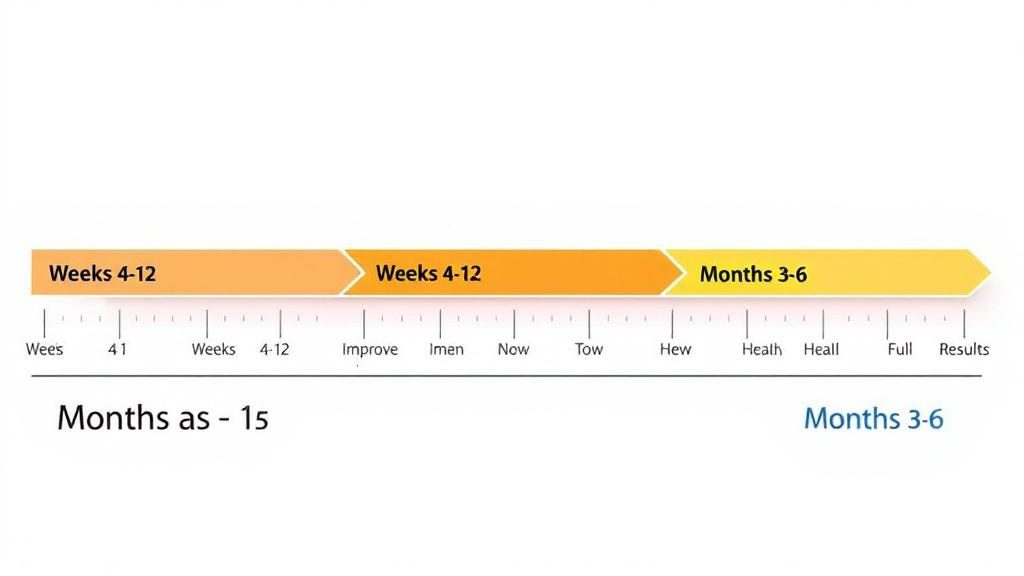
One of the biggest mistakes people make with regenerative medicine is expecting immediate results.
You've been dealing with pain for months or years. You're desperate for relief. You want to believe one injection will fix everything overnight.
That's not how regenerative medicine works.
It's a process. It takes time. The results are often life-changing, but they don't happen instantly.
Realistic expectations look like this: In weeks one through four, you might not feel dramatically better yet. In fact, you might feel worse initially due to inflammation. That's normal.
Weeks four through twelve is when most people start seeing real improvement. Pain decreases. Function improves. You can do things you couldn't do before. The trajectory is positive, even if you're not at 100% yet.
Three to six months is when you see full results. Tissue is rebuilt. Pain is significantly reduced or gone. Function is restored. The improvement is lasting.
Going into regenerative medicine with these timelines in mind prevents disappointment. You understand what's happening at each stage and you're patient with the process.
Why Patience Is Part of the Treatment
In a world of instant gratification, waiting three to six months for results feels unbearable.
But real healing takes time.
You didn't develop chronic pain overnight. Your tissue didn't degenerate in a week. The damage accumulated over months or years.
Expecting that damage to be fully repaired in a few days or weeks is unrealistic. Your body needs time to rebuild, and rushing the process doesn't help.
Once healing is complete, it's lasting. You're not getting temporary relief that wears off. You're getting actual tissue repair that changes the trajectory of your pain and function for years to come.
That's worth waiting for.
Comparing Regenerative Medicine Timelines to Other Treatments
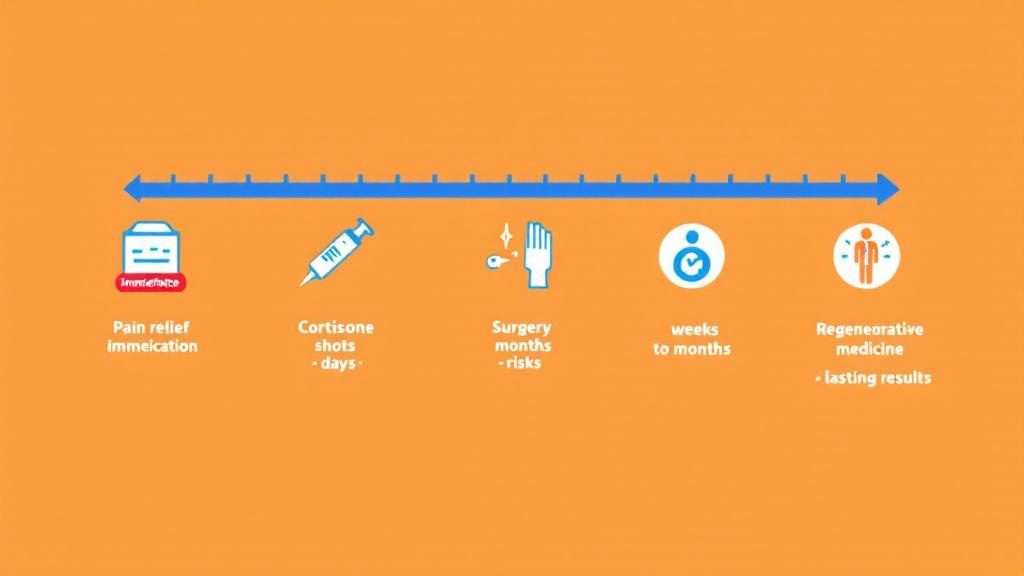
If you're comparing regenerative medicine to other pain treatments, understand what you're comparing.
Pain medications work within hours or days. But they don't heal anything. They just mask pain temporarily, and you have to keep taking them indefinitely.
Cortisone injections provide relief within a few days, but effects wear off in weeks or months. They also damage tissue over time with repeated use.
Physical therapy can take weeks to months to show improvement, depending on the condition. It's effective for functional problems but doesn't repair structural damage.
Surgery has a long recovery time—often three to six months or more—and comes with risks, complications, and no guarantee of success.
Regenerative medicine takes weeks to months to show results, but it actually repairs tissue. The improvement is progressive and lasting, not temporary.
When you compare timelines, you also have to compare outcomes. Fast relief that wears off isn't better than slower relief that lasts.
Why Regenerative Medicine Is Worth the Wait
You could take a pain pill today and feel better in an hour. But tomorrow, you'll need another pill. And the next day, another. And on and on.
Or you could commit to regenerative medicine, give your body the time it needs to heal, and potentially eliminate the need for those pills altogether.
The choice isn't between fast relief and slow relief. It's between temporary management and lasting repair.
Regenerative medicine takes longer upfront, but it changes the long-term trajectory. You're not just surviving your pain—you're eliminating the source of it.
That's a fundamentally different outcome.
What to Do While You're Waiting for Results

You've had your regenerative medicine treatment. Now what?
You can't just sit around for three months waiting to feel better. There are things you can do to support the healing process and maximize results.
Follow your provider's activity guidelines. If they say rest for a week, rest. If they say start gentle movement at week two, do that. Don't improvise.
Stay consistent with chiropractic care. Your nervous system controls healing. Keeping your spine aligned and your nervous system functioning optimally accelerates tissue repair.
Eat to support healing. Focus on protein for tissue building, healthy fats for reducing inflammation, and plenty of fruits and vegetables for vitamins and minerals.
Prioritize sleep. Aim for seven to nine hours per night. That's when your body does most of its repair work.
Manage stress. High cortisol levels from chronic stress slow healing. Find ways to relax—meditation, walks, breathing exercises, whatever works for you.
Attend follow-up appointments. Your provider needs to track progress, make sure you're healing properly, and adjust the plan if needed.
Be patient but proactive. Give your body time to heal, but stay engaged in the process. If something feels wrong, speak up. If you're not seeing progress, communicate with your provider.
Staying Active Without Sabotaging Healing
One of the biggest challenges during regenerative medicine recovery is knowing how much activity is safe.
Too much activity too soon damages healing tissue and sets you back. Too little activity causes stiffness, weakness, and poor circulation, which also slows healing.
The key is gradual progression guided by your provider.
In the first one to two weeks, you'll likely be told to rest and avoid stressing the injured area. That doesn't mean complete immobilization—gentle movement is usually encouraged to maintain circulation.
By weeks three to six, you'll start gradually increasing activity. Light stretching, low-impact movement, gentle strengthening exercises. The goal is supporting healing without overwhelming the tissue.
By weeks eight to twelve, you'll be cleared for more normal activity, though you'll still need to be cautious. Full return to intense exercise or sports usually happens around the three to four month mark, depending on the condition.
Your provider will give you specific guidelines based on your injury and progress. Follow them. Don't push harder or faster just because you're feeling better. The tissue is still rebuilding, and premature stress can undo progress.
The Bottom Line on Regenerative Medicine Timelines
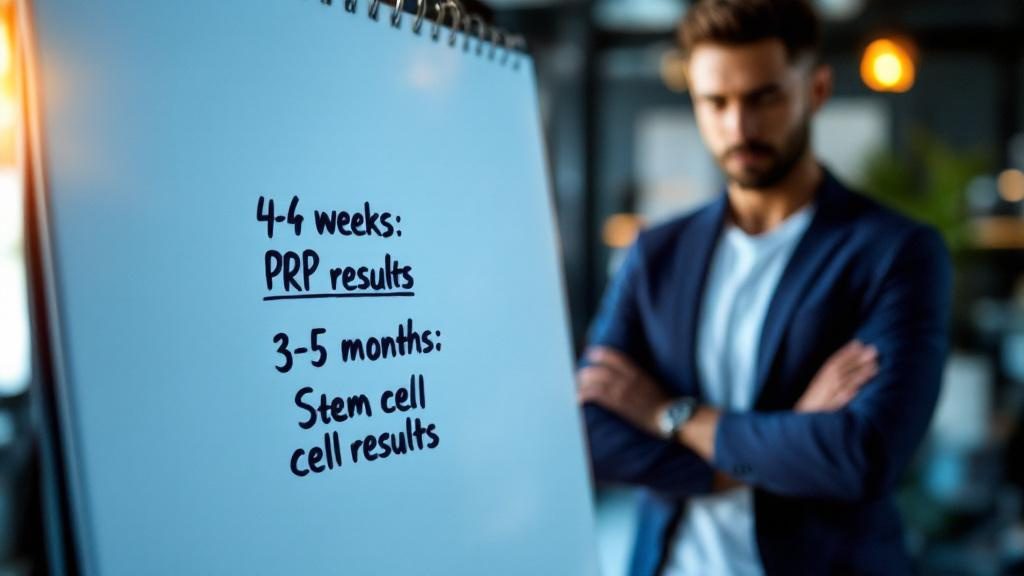
So how long does regenerative medicine take to work?
For PRP therapy, most people see improvement in four to eight weeks, with full results by three to four months.
For stem cell therapy, improvement usually starts around eight to twelve weeks, with full results by four to six months.
Some people respond faster, some slower. Multiple treatments are often needed for complex conditions. The timeline depends on your specific injury, overall health, and how well you support the healing process.
Regenerative medicine isn't instant, but it's lasting.
You're not getting temporary relief that fades after a few weeks. You're getting actual tissue repair that changes your pain and function for the long term.
That's worth the wait.
If you're dealing with chronic pain, injuries that won't heal, or degeneration that's limiting your life, regenerative medicine might be exactly what your body needs. When combined with chiropractic care that optimizes your nervous system and supports healing, the results can be transformative.
Regen and Restore in Casper specializes in regenerative medicine treatments and works with patients to set realistic expectations, track progress, and adjust treatment plans as needed. Because they're located in the same building as Atlas Chiropractic, care stays coordinated and comprehensive.
Ready to start your healing journey? Learn more about your options and take the first step toward lasting relief.
Your body knows how to heal. Sometimes it just needs the right tools and enough time to do the job right.
Recent Blog Posts...
How Long Does Regenerative Medicine Take to Work?
Regenerative Medicine: A New Approach to Chronic Pain
Regenerative Medicine Options: PRP vs Stem Cells
When to Consider Regenerative Medicine Treatment
Living With Pain
Care of Concussions
Office Hours
2:00 PM - 5:30 PM
2:00 PM - 5:30 PM
Office Hours
2:00 PM - 5:30 PM
2:00 PM - 5:30 PM
Copyright 2025 | Atlas Chiropractic | All Rights Reserved | Website by iTech Valet






